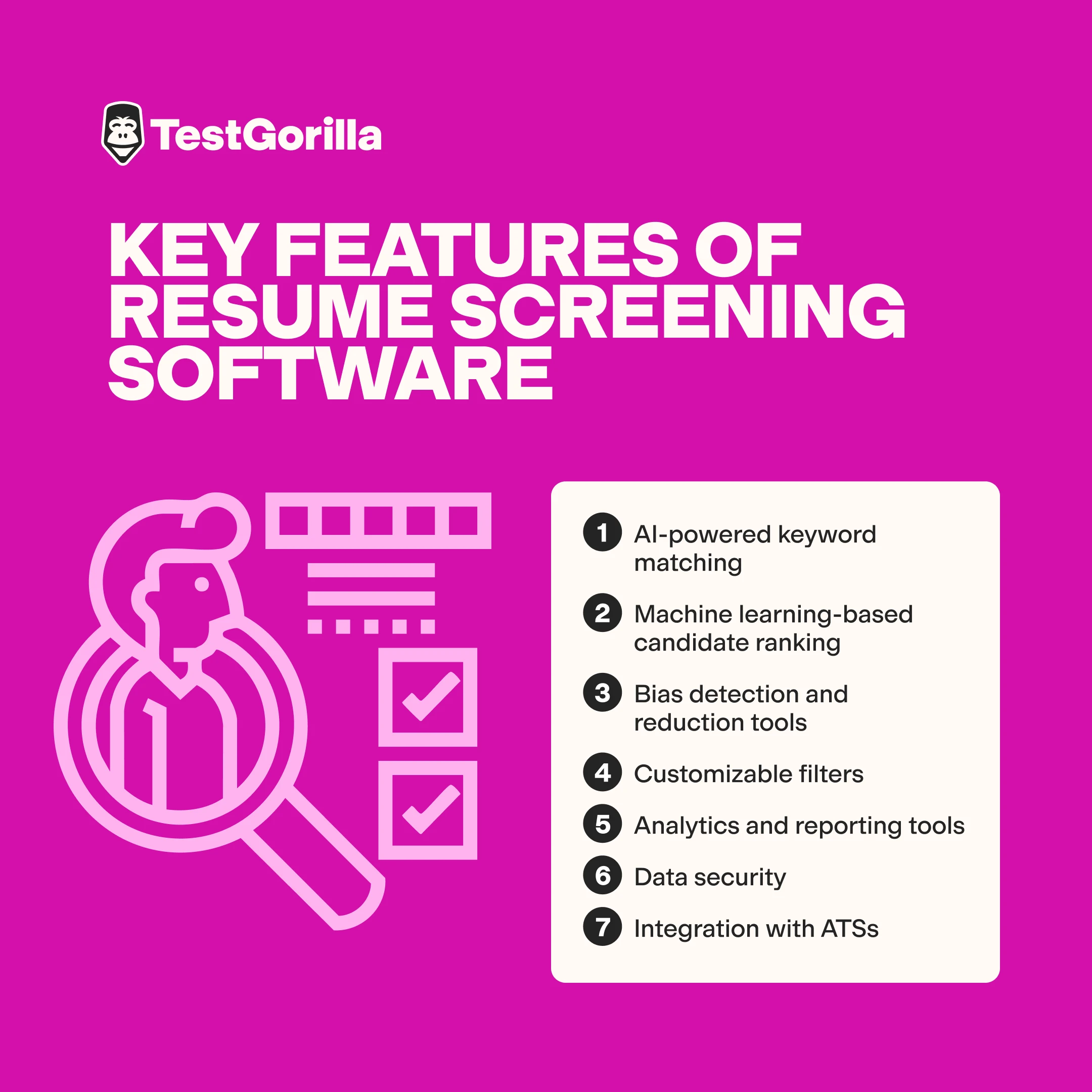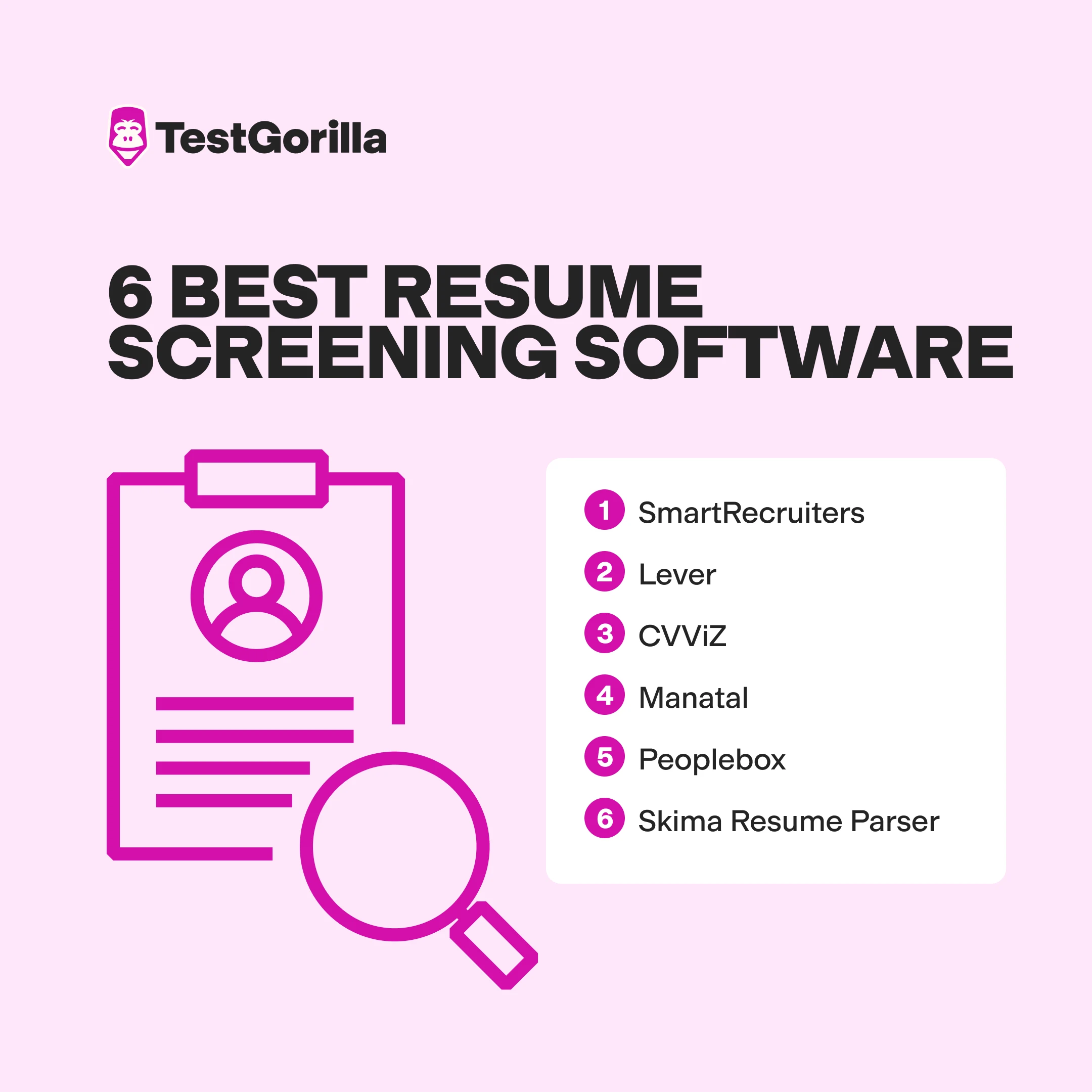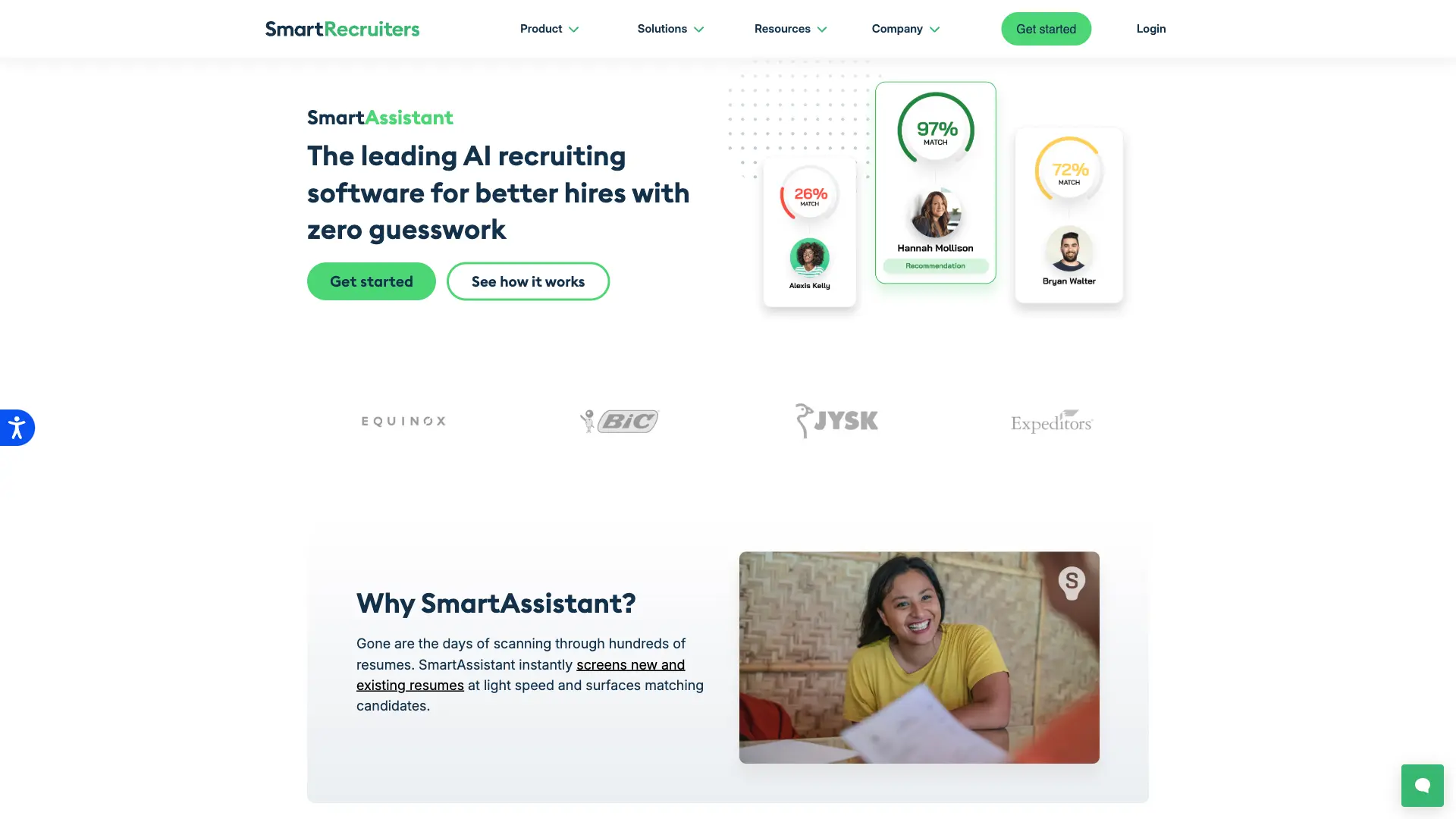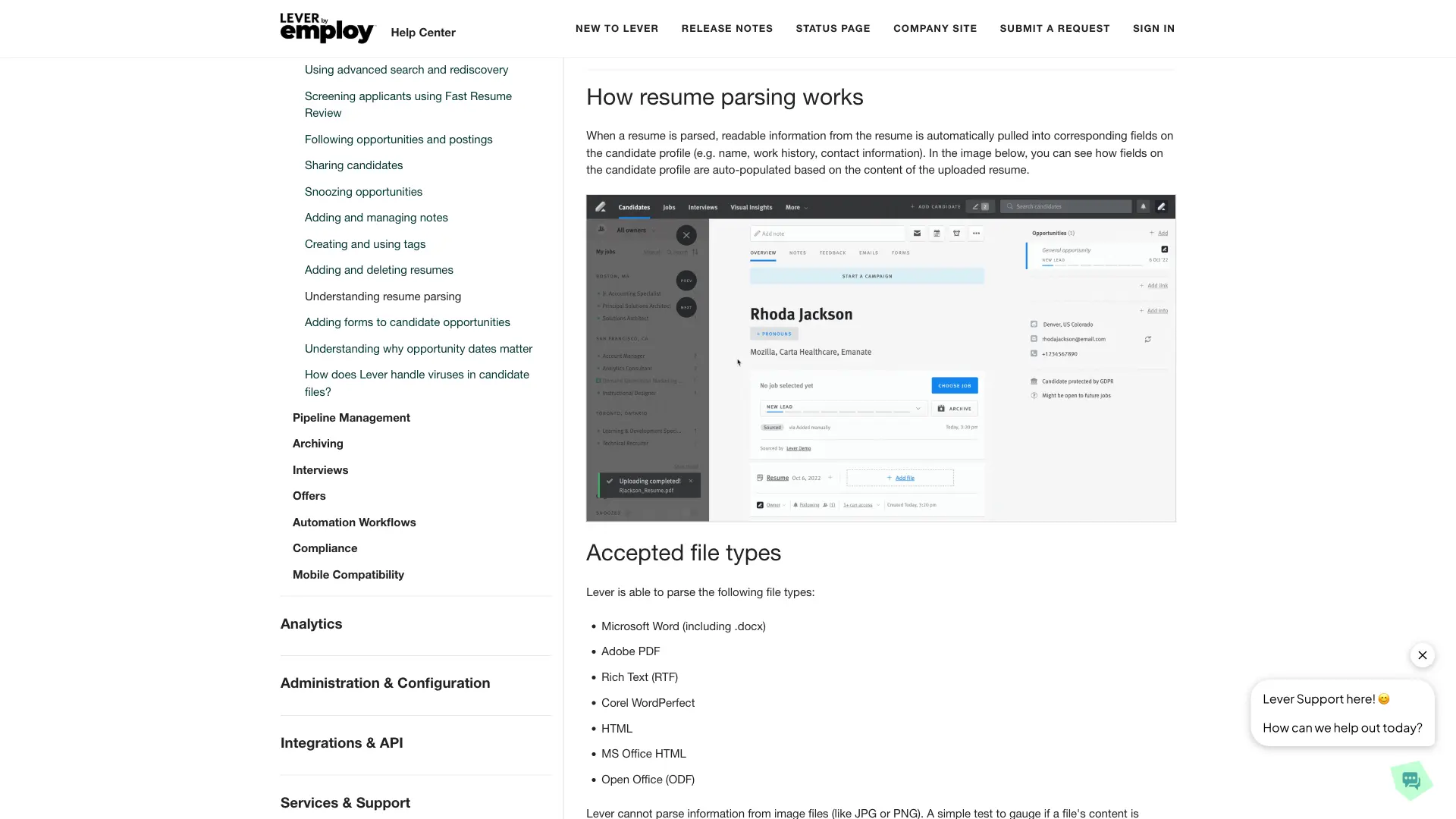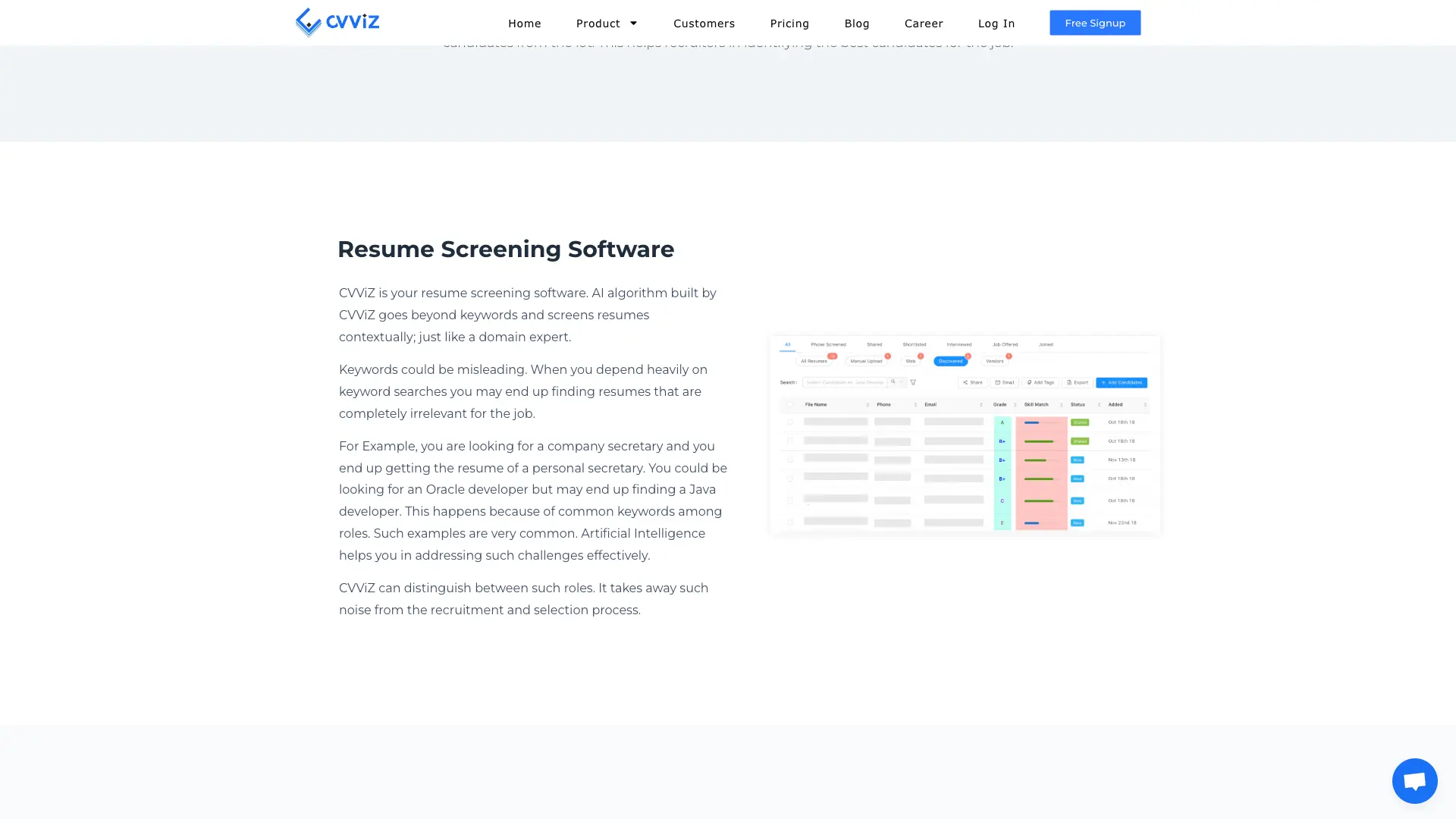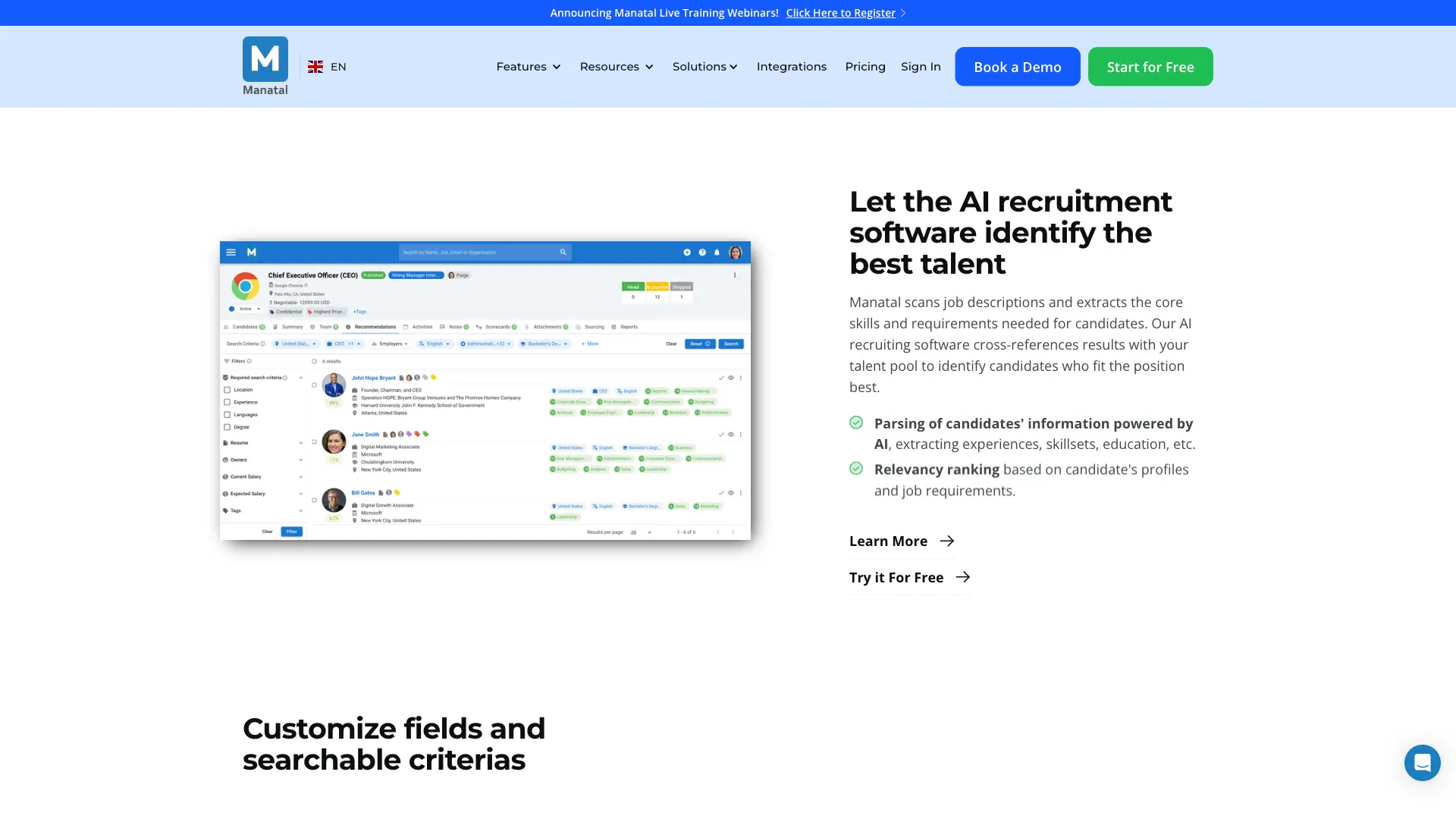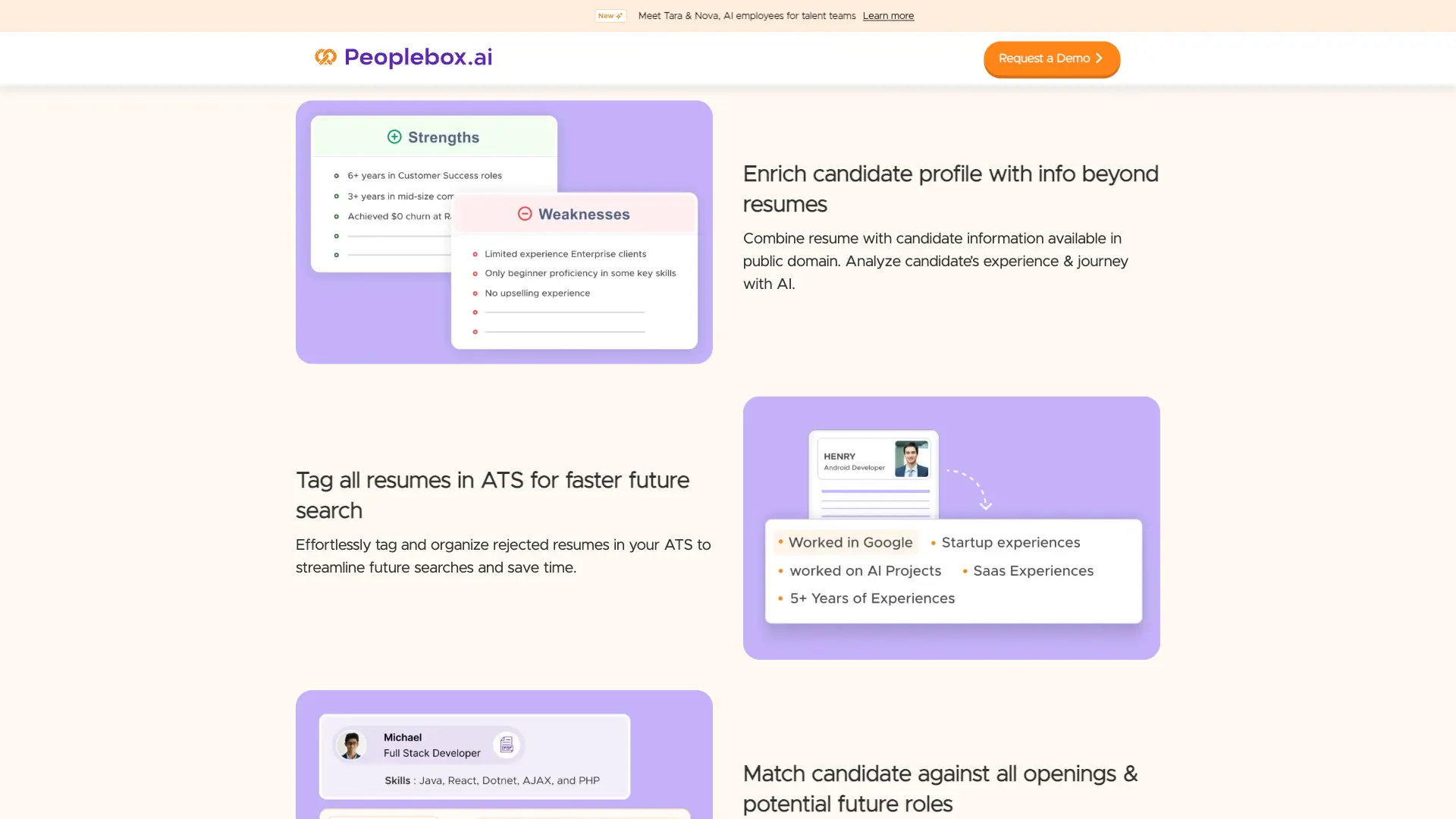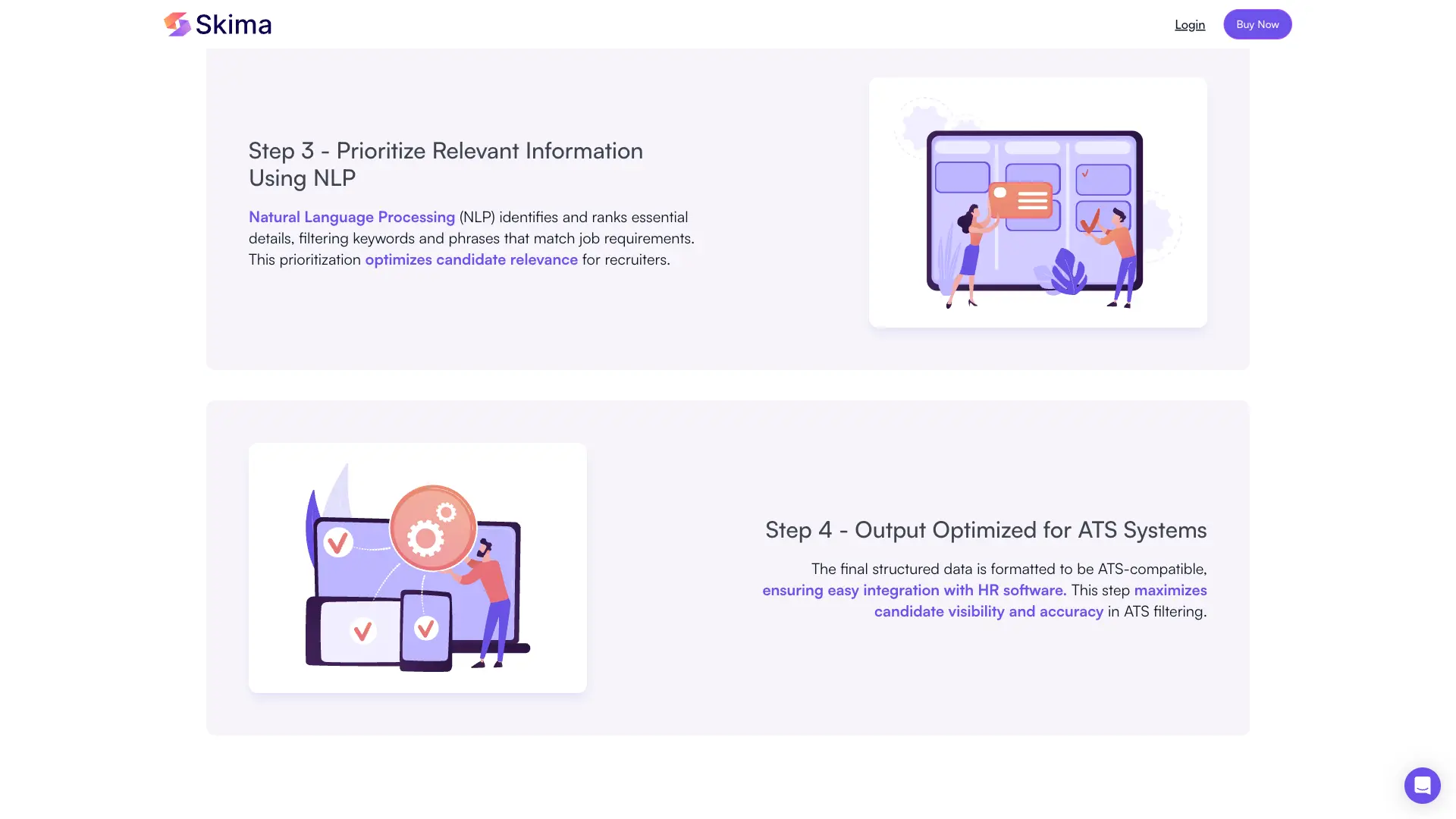Resume screening software: A guide for HR professionals (including alternatives)
Manually screening tens – or sometimes hundreds or even thousands – of resumes is a time-consuming and ineffective process for busy employers and HR teams. This process also lacks consistency, increasing the risk of unconscious bias in the hiring process and poor hiring decisions.
It’s no surprise that more and more hirers are turning to resume screening software. However, it’s important to take a considered approach to using these tools.
In this article, we look at the pros and cons of using this software, how to choose the best resume scanning tool for your business, and how using it alongside a skills-based approach to hiring can help you find the best-skilled candidates.
Table of contents
- What is resume screening software?
- Why are resume screening tools important to HR professionals?
- The benefits and drawbacks of resume screening tools
- 6 best resume screening software
- 6 best practices for leveraging resume sorting software in your HR department
- Talent assessments: Alternatives to resume screening tools
- 3 examples of companies succeeding with resume scanning software and talent assessments
- Combine resume screening software with pre-interview assessments to hire the best candidates
- Resume screening software FAQs
What is resume screening software?
Resume screening software (also known as CV screening software) is a technology that helps recruiters quickly identify the most suitable candidates by scanning resumes for keywords or phrases and ranking applicants. Most resume screening software is AI-powered, using algorithms and machine learning to analyze, compare, and rank candidate resumes.
You can use these tools as standalone software or integrate them with an applicant tracking system (ATS). By automating resume screening, this software streamlines the hiring process, saves recruiters time, and helps reduce the risk of unconscious bias affecting hiring decisions.
Key features of resume screening software
Key features to look for when choosing a CV screening tool include:
AI-powered keyword matching that uses algorithms to find keywords that align with job descriptions in resumes – including keywords for specific skills, experience, and education
Machine learning-based candidate ranking that orders applicants based on how well they fit the job requirements
Bias detection and reduction tools that help ensure fairness by identifying biased language and removing personal identifying information – like gender or age – from applications
Customizable filters that enable recruiters to order candidates based on preferred criteria – for example, specific skills
Analytics and reporting tools that give recruiters actionable insights into factors like hiring trends and candidate sources
Data security features to protect candidate information and ensure compliance with data regulations
Integration with ATSs to automate workflows and streamline the hiring process
Why are resume screening tools important to HR professionals?
The primary use of resume sorting software for HR professionals is to save time. This is desperately needed, as most HR workers don’t have enough time to spend on strategic or long-term projects. Research from McKinsey shows that most HR departments still spend about 60% of their time and resources on routine and administrative tasks.
Cutting out unnecessary tasks leaves more room for high-impact activities like interview preparation or marketing optimization on recruiting platforms.
Resume screening tools also make the recruitment process more accurate.
Important information can go unnoticed when humans have to manually scan hundreds of resumes. You can lose great candidates because of this – or make a costly mis-hire because you failed to properly check a candidate’s credentials.
Resume screening software saves your company money on:
Overhead, because you spend less time on candidate screening
Recruitment, because you can create shortlists faster and are therefore less likely to miss the best talent
Work quality, because you’re more likely to find a good match for the role
Re-hiring, because you’re less likely to make a mis-hire
The best insights on HR and recruitment, delivered to your inbox.
Biweekly updates. No spam. Unsubscribe any time.
The benefits and drawbacks of resume screening tools
We now know what resume scanning software is supposed to do.
But what are its advantages and disadvantages?
Benefits of automated resume screening software
There are five main advantages to using automated resume screening software:
It saves time and effort, increasing hiring efficiency.
In doing this, it reduces overhead costs.
It improves candidate experience by streamlining the hiring process.
This increased efficiency reduces time-to-hire and improves quality of hire.
When configured correctly, it can reduce bias in hiring – for example, research shows that human recruiters are less likely to call back candidates with “ethnic”-sounding names, particularly women. This is less likely with resume scanning software.
Drawbacks of resume screening software
However, resume scanning software isn’t without its flaws:
Resumes are all different, making it hard for resume screening tools to tell quality candidates apart from bad fits.
Resumes aren’t always honest: 70% of candidates admit to lying on their resumes, while 15% consider lying.
Research shows that pre-hire work experience is not a good indicator of future performance, nor does it predict retention.
Resume scanning software can also negatively impact candidate experience. It may give top candidates the impression that their application is subject to algorithms rather than being given due consideration by a human recruiter.
Although resume screening tools can save time, skills testing is a more reliable and efficient form of resume evaluation.
6 best resume screening software
Whether resume screening is an essential step in your recruitment process or you want to transition slowly to more skills-based hiring methods, resume screening software can be a good way to streamline your processes.
Here are six recommendations.
How we evaluated resume screening software
Let’s first discuss the criteria for good resume screening software.
Integrations: Most resume screening tools come as part of an ATS or other form of recruitment software that stores candidate data and contact information. Integrating this system with skills testing platforms like TestGorilla gives you the option of testing candidates in addition to evaluating resumes.
Scalability: Don’t get sucked in by a reasonable introductory offer and find yourself paying through the nose as you grow. All the options below empower you to start scaling hiring without breaking the bank.
Customization: From your pipeline to the criteria you’re looking for in each resume, customization is key to get the results you need.
User-friendliness: If your employees avoid using a tool because it’s complex or clunky, you won’t get a return on your investment.
AI: AI resume screening enhances your resume evaluation process by mining key insights from each application. It’s not an essential feature, but we’ve underlined it where available.
6 best resume screening software: Summary table
Already snowed under by resumes and need the best resume scanning software as soon as possible? Here’s a summary.
Best resume screening software | Benefits |
1. SmartRecruiters | - Best for startups - Easy to use - Good access to customer service - Offers a free plan for an unlimited number of users |
2. Lever | - Best for scaling hiring efforts - Enables recruiters to review job applications in a time-saving “sprint” sequence |
3. CVViZ | - Best for contextual resume screening - Offers real-time candidate ranking - Easily scalable |
4. Manatal | - Best for AI resume screening - AI resume screening picks out key insights from each resume - Integration with some testing platforms - Easy to blend into your HR tech stack |
5. Peoplebox | Best for generating selection criteria Transparent pricing Also offers AI-powered performance management and employee engagement tools |
6. Skima Resume Parser | Best if you’re looking for a standalone resume screening tool Free plan available and affordable pricing |
1. SmartRecruiters: Best for startups
Like the other resume screening software on this list, SmartRecruiters is a cloud-based ATS that offers resume screening with its product SmartAssistant.
Alongside its resume screening capabilities, SmartRecruiters offers other products, including:
An HR dashboard that collates relevant insights into your recent hiring efforts
Smart job distribution posting, which analyzes which job boards deliver the highest ROI
Scorecards that help standardize interviewer feedback
Integrations with skills testing platforms, including TestGorilla
Pros:
Easy to use
Solid customer service
Highly scalable
Cons:
Pricing isn’t transparent
Doesn’t enable you to build personalized dashboards
Rating: 4.3 out of five, 494 reviews (G2)
Pricing at time of writing: Available on request
2. Lever: Best for scaling hiring efforts
Lever is an ATS with a wealth of integrations, including one with TestGorilla. It includes a resume parser feature that extracts key information from candidates’ resumes and enters into its system automatically.
Its Fast Resume Review feature enables recruiters to review candidates’ applications in a “sprint” sequence that reduces time spent on screening. Detailed analytics and reporting give recruiters insights into how to improve and streamline the hiring process.
Pros:
Integrates with skills testing software
Fast Resume Review feature
Detailed analytics
Cons:
Extensive range of features may not be suitable for some businesses
Pricing isn’t transparent online
Rating: 4.3 out of 5, 2,035 reviews (G2)
Pricing at time of writing: Available on request
3. CVViZ: Best for contextual resume screening
CVViZ is an ATS that also offers resume screening software.
Rather than simply scanning for keywords, CVViZ’s technology takes context into account. This makes it more precise – it can distinguish between similar roles and prioritize the skills you’re looking for.
It then ranks candidates in real time, giving you data to use immediately to decide who to interview. Plus, CVViZ uses data from your hiring activities to constantly update its processes.
Pros:
Free trial available
Contextual screening that goes beyond keywords
Easily scalable
Cons:
Somewhat complicated pricing structure
No white labeling available
Rating: 4.4 out of five, 43 reviews (G2)
Pricing at time of writing: Plans start at $99/month for up to 5 active jobs + AI resume screening for $25/job
4. Manatal: Best for AI resume screening
Manatal is a recruitment software with ATS, AI, and reporting features. It includes automated resume parsing features and uses AI to collect information from social media to gain more insights into candidates.
The platform can extract, index, and rank candidates’ skills from their resume and sites like LinkedIn. Using this information, you can use Manatal to create standardized, anonymized resumes for your hiring team to review.
Manatal offers extensive integrations with testing platforms and other hiring software.
Pros:
AI capabilities speed up shortlisting suitable candidates
14 day free trial
Integrations make it easy to blend into your tech stack
Cons:
Per-user pricing can add up
Doesn’t specifically focus on candidate experience
Rating: 4.8 out of 5, 142 reviews (G2)
Pricing at time of writing: Starts at $15/month/user
5. Peoplebox: Best for generating selection criteria
Peoplebox is designed to help manage several stages of the employee lifecycle, including candidate screening. Its AI resume screening tool can add publicly available information to candidates’ resumes, giving a full picture of their potential.
Peoplebox can also analyze top performer data to define selection criteria for roles and match well-suited candidates.
The platform offers performance management and employee engagement tools, too.
Pros:
ATS integrations
Can generate selection criteria
AI analytics of candidates’ journeys
Cons:
Per user pricing model can add up
Many integrations still in development
Rating: 4.5 out of five, 346 reviews (G2)
Pricing at time of writing: Plans start at $7/month/user
6. Skima Resume Parser: Best for a standalone resume screener
A newer platform, Skima’s Resume Parser analyzes resumes and extracts relevant data directly into your ATS. The tool can process resumes in various formats, including PDFs, DOC, and DOCX.
According to the platform, it’s 99% accurate and can read thousands of resumes in minutes.
Skima’s other recruiting solutions include AI Matching Score, an algorithm that assesses candidates’ resumes and compares them against the job criteria, ranking candidates. The platform also offers an AI Job Description Generator.
Pros:
Free plan for up to 100 resumes
Standalone resume screening tool, which may be more affordable
Scalable
Cons:
Limited features compared with other resume screening tools
Some users report an initial learning curve
Rating: NA (no G2 review currently available)
Pricing at time of writing: Starts at $99 for up to 3,000 resumes
6 best practices for leveraging resume sorting software in your HR department
Of course, having the best resume scanning software on the market is only the beginning. You need to be using these tools correctly to reap the full harvest of benefits we’ve outlined above – here are six best practices to ensure return on your investment.
6 best practices for using software for resume screening: Summary table
If you’re eager to get started with resume screening tools, these points should be on your to-do list.
Best practices for using software for resume screening | Key points |
1. Get your team involved in tool selection | - Ask hiring managers what problems the resume screening tool needs to fix - Invite select staff members to sit in demos - Send employee pulse survey during and after implementation |
2. Define your screening criteria | - Build time to tailor resume screening requirements into your hiring process - Create a screening checklist including: Work experience, education, soft skills, technical skills, personality traits |
3. Remove degree requirements from job listings where appropriate | - Remove degree requirements except for roles where they are strictly necessary - Complement with skills testing |
4. Communicate proactively with candidates | - Use your ATS to send automated update emails - Set up an alert to check in with candidates - Use an HR chatbot to field common queries |
5. Look out for bias | - Ensure you’re using representative data to inform artificial intelligence (AI) resume screening tools - Use a bias dashboard to monitor your resume parsing |
6. Combine resume screening software with talent assessments | - Test candidates for core skills - Test candidates for basic aptitude in skills you will need in future |
1. Get your team involved in tool selection
Whether you have one hiring manager or 100, you need to involve them in tool selection. Start by asking what inefficiencies they need the tool to address. For example, do your current tools bring up too many unqualified candidates?
Once you understand the problems your resume screening tool must fix, get your hiring teams on board. Ensure they:
Have the skills to use it
Are able to see the problems it solves, and how
Understand its processes and how to customize it
(Most importantly) Enjoy using it
These aren’t throwaway tips: 17% of organizations hold back from HR tools due to lack of tech skills.
To get buy-in from hiring managers, invite select staff members to sit in on the demo calls and ask questions.
Importantly, keep asking what they think after you’ve bought the tool and during testing – for example, with an employee pulse survey.
2. Define your screening criteria
Always tailor the screening criteria for each role to avoid accidentally screening out candidates with valuable skills. On your resume screening checklist, there should be five factors:
Work experience: How many years of experience do you require for this role? Is it necessary, or a preference?
Education: Does this role require a college degree or other certifications? (More on this question below.)
Soft skills: For example, do the right candidates need to be good verbal communicators or people managers?
Technical skills: What concepts or technologies should the candidates be familiar with?
Personality traits: What personality traits would benefit them in this job, team, or company culture?
Any good ATS makes tailoring the criteria easy with an advanced search option. Manatal, for example, enables you to search by key skills (such as strategic partnerships) and rate – out of ten – how critical each skill is for your job search out of ten. It then tailors the results to your specific requirements.
3. Remove degree requirements from job listings where appropriate
Using degree requirements is a convenient solution to quickly cut out resumes, particularly when manually screening. But having a strict degree requirement for jobs where it’s not absolutely necessary negatively impacts your candidate sourcing.
Due to inequalities in education in the US, adding a four-year degree to a job ad cuts out around 62% of US workers older than 25. This includes:
72.4% of Black Americans
79.1% of Hispanic workers
58.2% of non-Hispanic White workers
Some job titles need degree requirements – for example, medical and some legal roles – but most do not.
Many employers recognize this and are “resetting” degree requirements, removing the “paper ceiling” (degree requirement) for STARS (candidates who are skilled through alternative routes).
A massive 46% of middle-skill and 31% of high-skill jobs have experienced degree resets in recent years. Although resume screening software can save heaps of time for open positions that do require degrees, always ask yourself whether a degree is an unavoidable necessity or simply a nice-to-have for a job opening.
4. Communicate proactively with candidates
Speed is essential when communicating with candidates. More than half lose interest if they don’t hear back within two weeks after the first interview, and this jumps to 77% within three weeks.
With this in mind, don’t let the time you save from cutting out manual resume screening go to waste:
Use your ATS to send out automated update emails
Set up an alert to check in with candidates at certain intervals
Use an HR chatbot to field common queries outside business hours
5. Look out for bias
The need for vigilance against bias in hiring doesn’t go away when you’re using resume screening software.
Amazon had to get rid of its AI resume screening tool because it was biased against women. This is because it made predictions based on a sample of resumes dominated by men.
One way you can avoid these pitfalls and create an inclusive culture at your workplace is by using a bias dashboard.
A bias dashboard is an additional dashboard that analyzes how analytics tools such as a resume parser perform for different groups, flagging biased results. You might set this up yourself or ask your ATS provider to help you.
6. Combine resume screening software with talent assessments
Resume screening tools have many limitations. Candidates frequently embellish their resumes and may lack insight into their own skills.
Plus, companies’ skills needs are changing with the rise of automation tools like AI. And candidates aren’t best placed to recognize what these skills are and flag them on their resume.
With skills tests, you decide what to test and can tailor assessments to your changing requirements, leading to data-driven recruiting decisions.
You can then use resumes later in the process to gain context on the candidate’s experience and necessary qualifications – or scrap them completely.
Talent assessments: Alternatives to resume screening tools
Resumes aren’t always reliable. The internet is filled with advice for candidates on how to “game the system” by making a more algorithm-friendly resume or using a resume template. Plus, candidates are increasingly using AI-generated resumes – which can be exaggerated or totally fabricated.
We therefore recommend scrapping resumes and cover letters and replacing them with pre-employment skills testing. Or, you can screen resumes later on in your hiring process – for instance, after you use skills testing to screen your applicants.
At TestGorilla, our skills tests have anti-cheating protocols in place to prevent candidate fraud.
Skills assessments can also be tailored to your hiring needs for each specific job (unlike resumes).
Skills tests are more accessible to remote candidates and candidates with a wide variety of needs and disabilities. TestGorilla offers inclusive adjustments, including:
The option to answer verbally for individuals with motor disabilities
More time to answer for candidates with language processing disorders
Extra breaks to help candidates avoid overstimulation
Different formats for those with visual impairments
You can even use skills assessment data after hiring – for example, to focus employees’ training on weak areas of their skillset.
The results speak for themselves. Our State of Skills-Based Hiring 2024 report found that 88% of employers reduced mis-hires after switching to skills-based hiring, 74% of employers reduced cost-to-hire, and 84% improved diversity.
A separate study of more than 2,000 successful recruitments found that the number of women hired into senior roles increased by 70% when skills-based hiring processes were introduced.
3 examples of companies succeeding with resume scanning software and talent assessments
All of this sounds good in theory, but is anyone actually doing it?
Here are three examples of organizations succeeding with resume screening software, resume alternatives, or a combination of both:
Brightsparks
Hydroemission
Medal.tv
1. Brightsparks
Brightsparks is a UK-based organization that matches 14,000 college students each year with temporary employment opportunities.
Over time, Brightsparks recognized that Gen Z students disliked traditional application processes and started to look for resume alternatives that would still give hiring managers the data they needed on each applicant. They found SmartRecruiters’ ATS to be a great way of quickly assessing large volumes of candidates, using skills testing to reduce bias and increase diversity.
2. Hydroemission
Hydroemission is a controlled-release technology provider for environmental applications. Historically, the company would filter resumes manually before inviting candidates to interview, but this was a labor-intensive process that didn’t produce fool-proof results.
It needed a solution to assess candidates’ cognitive abilities before inviting them to interview to save time and money during hiring.
Using TestGorilla, Hydroemission successfully cut down its time-to-hire by 80% by combining resume screening with skills testing.
Its hiring process now looks like this:
Resumes are collected, screened, and sent to the head of department for review
Candidates are invited to take a cognitive assessment and a Time Management test
Successful candidates receive a take-home assignment to present online
The most skilled candidate is invited to interview
The Hydroemission team extends an employment offer
3. Medal.tv
Medal.tv is an application that enables users to clip gameplay on PC, Mac, and mobile devices without missing a frame.
As it grew, the burden of juggling spreadsheets and fragmented hiring data became less sustainable. The organization needed a centralized platform to effectively scale hiring.
Medal.tv used Lever to streamline the resume screening process, particularly the Fast Resume Review feature.
The ATS gave the company a unified overview of all hiring and skills data collected during the hiring process and enabled it to increase its headcount by 53%.
Combine resume screening software with pre-interview assessments to hire the best candidates
In this article, we’ve discussed everything you need to know about resume screening tools to make an informed purchase, including:
What resume screening software is
The benefits and drawbacks of using dedicated software for resume screening
What to consider when choosing a resume screening tool
The best resume screening software on the market right now
Best practices and when to consider resume alternatives, including skills-based talent assessments
Ready to switch to a skills-based hiring process and further optimize your hiring process with talent assessments?
Then book a demo with TestGorilla or start hiring better talent immediately by signing up for a free forever plan!
Resume screening software FAQs
Still have burning questions about resume scanning software? Here are some quick FAQs.
What software is used for resume screening?
Resume screening software is usually a feature of an applicant tracking system, or ATS. Many ATS platforms offer resume scanning capabilities, including:
SmartRecruiters
Lever
CVViZ
Manatal
What is an ATS for resumes?
An ATS is an applicant tracking system. This is software that traces a candidate’s journey all the way from a recruitment or social media platform – for example, Indeed or LinkedIn – through your hiring process and into your workforce.
ATS software usually includes resume screening tools to quickly identify candidates with the required skills and create a shortlist.
How much of an ATS score is required?
It’s generally thought that for a resume scanning software to pass a resume to a human recruiter, the resume must meet 80% of the job ad requirements. That said, few ATS resume screening tools publicize their scoring criteria, and it may be different from ATS to ATS and job posting to job posting.
If the resume meets between 20% and 80% of job requirements during parsing, the ATS may store it in a database for the future. If it doesn’t meet the 20% threshold, it’ll likely be discarded.
How does resume screening software work?
Resume screening software works by picking out relevant keywords from each resume that match the requirements of the job description – for example, Python coding skills.
AI resume screening tools use machine learning to take keyword matching even further, pulling from a dataset of successful resumes to predict which attributes make for successful hires – for example, two years’ experience with a specific coding language.
You've scrolled this far
Why not try TestGorilla for free, and see what happens when you put skills first.


